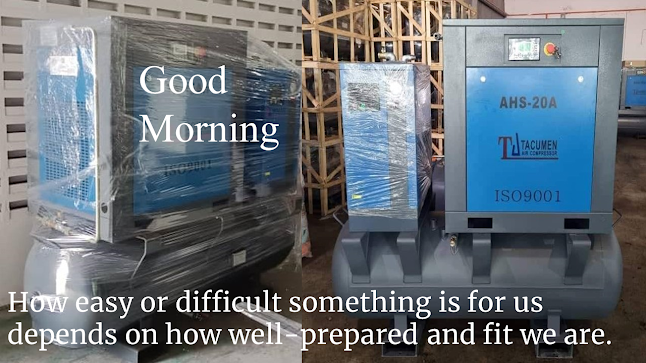Compressed Dried Air
The atmospheric pressure of air, which are measured barometrically, vary depending upon its position relative to sea level.
When air is compressed above atmospheric pressure, its characteristic is to attempt to return to its normal state.
Since compression of air requires energy input, energy is then released as compressed air returns to atmospheric pressure.
Compressed air is one of the most versatile and useful forms of energy available.
It is used to operate automobile lifts, inflate tires, operate tools, spray paint, many automated machinery in production plants and many other uses in all industries.
Compressed Air for Power
Compressed air is widely used for power. Internal energy stored in compressed air is directly convertible to work; no conversation from another form of energy such as heat is involved, at least not at the point of used. Pneumatic components are therefore characterized by a notably high ratio of power to weight or power to volume.
Compared to equipment, which involve translational forces in a variable force field, compressed air produces smooth translation with more uniform force. Not as fast as electricity, nor as slow as hydraulic, pneumatics finds a broad field of application for which its response and speed makes it ideally suited.
Where there is an overlap, the choice is often one of economics, and air is likely to hold the advantage. In addition, air doers not possess the potential shock hazard of electricity nor the potential fire hazard of oils.
The attributes of compressed air lead to its application in many different kinds of components.
Pneumatic tools producing torque and rotation such as drills, brushes, nut runners and screw drives are common examples. These are generally powered by some form of rotary air motor such as the vane or lobe type, or by an air turbine. Equally common are components producing lateral motion and direct force, either steady or intermittent, with either manual or automatic control.
Common examples are clamps, presses and automatic feeds. Often air pressure is used to accelerate a mass, which then exerts an impact upon an anvil, as in paving breakers and pile drivers.
Common applications in industrial plants and or construction sites are air powered nailers and staplers.
In paint spraying and, to a considerate extent, in air conveying, motion is impacted essentially by the dynamic pressure of the air.
Advantages of Air Power
High ratio of power to weight in air tools contributes to low operator fatigue.
Air tools run cooler; do not generate heat in performing work.
Air tools have variable speed and toque control.
Compressed air is clean, has no fire hazard, no electric shock potential.
Pneumatic vs. Electric
Safety … Air powered equipment reduces the danger of electric shock and of fire hazard. Air tools run cooler and have the advantage of not being damaged from overload or stalling.
Lightweight … The air tool is lighter in weight and lends itself higher rate of production per man hour with less worker fatigue.
Flexibility … Due to its ability to provide a source of power by means of engine driven portable compressors, air tools can be operated in areas where other power sources are unavailable.
Cost … Due to fewer moving parts and their simplicity of design, air tools provide low cost maintenance and operation.
Pneumatic vs. Hydraulic
Safety … Unless fire resistant fluids are used, hydraulic-powered components operating near open flame or high temperatures present fire hazards. Compressed air components operate with lower system pressures. Accidental air leaks release no contaminants, as with hydraulic.
Low Initial Cost … Fewer parts make up a pneumatic system and the use of a single compressed air supply permits operation of many separate systems. Simple and less costly controls are possible with compressed air.
Flexibility … Compressed air systems provide for simpler installation, particularly where tools are frequently interchanged, such as in automotive service. Compressed air systems offer good adaptability for automation and flexibility for changing or expanding operations.
Maintenance … Pneumatics have less down time than do hydraulics, which have more complex controls and systems. Less preventive maintenance is required with air, whereas hydraulic fluids must be monitored and replaced periodically.
Leakage … Leakage in hydraulic systems results in the presence of hydraulic fluids that are dangerous to the surrounding area, whereas pneumatic system leaks do not contaminate the work area. In addition, leaks in hydraulic systems can result in complete system shutdown.
Summary
Benefits of Compressed Air:
* Easy to transport
* Easy to store
* Clean and dry
* Low weight
* Safe operation
* No accident hazard
* Rational and economical
* Simple
* Safe against overload
* Fast working medium
* Continuously up gradable.


























No comments:
Post a Comment